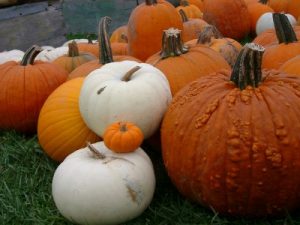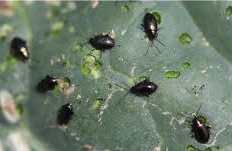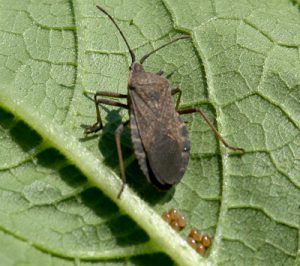Fall Means Pumpkins!
By Jennifer Naughton, Fairfax Master Gardener
 Growing pumpkins (Cucurbita pepo) is a great way to embrace the spirit of fall. To start this fun, child-friendly process, grow them from seed in the spring (average, 100 days to maturity) or compost jack-o’-lanterns or leftover decorative pumpkins from Thanksgiving. Seeds can survive the winter, and in the spring, the first signs of green are early pumpkin leaves sprouting from the garden floor like magic. To save space, transplant seedlings close to a garden fence or trellis and let them climb. The end product is a surprise due to cross-pollination with other squashes or pumpkins among the parent seeds. Sometimes they come back as gourds, some as tiny jack-o’-lanterns, others as full-size pumpkins. Use makeshift hammocks made out of plastic bags so they do not fall from the vines.
Growing pumpkins (Cucurbita pepo) is a great way to embrace the spirit of fall. To start this fun, child-friendly process, grow them from seed in the spring (average, 100 days to maturity) or compost jack-o’-lanterns or leftover decorative pumpkins from Thanksgiving. Seeds can survive the winter, and in the spring, the first signs of green are early pumpkin leaves sprouting from the garden floor like magic. To save space, transplant seedlings close to a garden fence or trellis and let them climb. The end product is a surprise due to cross-pollination with other squashes or pumpkins among the parent seeds. Sometimes they come back as gourds, some as tiny jack-o’-lanterns, others as full-size pumpkins. Use makeshift hammocks made out of plastic bags so they do not fall from the vines.

Flea beetles
Initially, a bumper crop of pumpkins is effortless. However, with real estate in the garden at a premium and with pumpkins’ proclivity to sprawl, even trellising and crop rotation do not guarantee elimination of overwintering pests. The first nuisance are usually flea beetles. They emerge mid- to late-spring and become active as the days get warmer. You’ll see their tiny black dots jumping on the leaves while larvae can also gnaw at the roots of the vine. This is a first sign that the plant is under stress. Glossy, bright green pumpkin leaves may now look chewed or paler in color. A first course of treatment is diatomaceous earth, but if not applied early enough or if spring/early summer is rainy, pyrethrin spray may prove more effective. After applying the spray for two weeks, seven days apart, the beetles will reduce in population or disappear altogether.

Striped cucumber beetle
The next pest challenge is the squash vine borer. It attacks mid-June through July when it emerges from cocoons in the ground. The squash vine borer is a moth that flies during the day and lays eggs one at time at the base of susceptible plants. To protect crops, row covers are utilized before flower pollination occurs. Monitoring the base of your vine is also helpful. Frass on the outside of your vine indicates a borer has made its way inside. To extricate, take a short blade knife and cut a vertical slit along the vine and scoop out the larva or larvae. Bury the base of the incised vine and cover with loose dirt.
Two other common pests are the squash bug and the cucumber beetle. To best control squash bug, check the underside of pumpkin leaves for their copper-colored eggs starting in mid-June. If identified, simply remove and dispose of the leaf. Do this as well with the light grey nymphs. Pick off adults and drop them in soapy water. Cucumber beetles appear in mid-August. They are easily confused with ladybugs due to their yellowish orange body with black spots.

Squash bug with copper-colored eggs
Both the squash bug and the cucumber beetle can devastate a pumpkin crop by transmitting bacteria. Squash bug causes the bacterium
Serratia marcescens, otherwise known as cucurbit yellow vine decline, and the cucumber beetle is associated with bacterial wilt. Again, pyrethrin is recommended as a successful control if used in a timely manner. Please refer to the VA Pest Management Guide, Chapter 2, for all recommendations of treatment for these insects, and be sure to follow the directions on the label.
Despite these challenging pests, pumpkins deliver a bounty of interesting shapes and sizes to decorate a fall garden. Try the variety Sugar Pumpkin for a seasonal pie or the heirloom Cinderella for a front porch. Pick a pumpkin in your very own backyard!
References
Cross-pollination between Vine Crops, Iowa State University Extension and Outreach, 1996
Featured Creatures: Squash Bugs, Florida State University, 2017
Home Vegetables, Chapter 2, 2018 VA Pest Management Guide
 Growing pumpkins (Cucurbita pepo) is a great way to embrace the spirit of fall. To start this fun, child-friendly process, grow them from seed in the spring (average, 100 days to maturity) or compost jack-o’-lanterns or leftover decorative pumpkins from Thanksgiving. Seeds can survive the winter, and in the spring, the first signs of green are early pumpkin leaves sprouting from the garden floor like magic. To save space, transplant seedlings close to a garden fence or trellis and let them climb. The end product is a surprise due to cross-pollination with other squashes or pumpkins among the parent seeds. Sometimes they come back as gourds, some as tiny jack-o’-lanterns, others as full-size pumpkins. Use makeshift hammocks made out of plastic bags so they do not fall from the vines.
Growing pumpkins (Cucurbita pepo) is a great way to embrace the spirit of fall. To start this fun, child-friendly process, grow them from seed in the spring (average, 100 days to maturity) or compost jack-o’-lanterns or leftover decorative pumpkins from Thanksgiving. Seeds can survive the winter, and in the spring, the first signs of green are early pumpkin leaves sprouting from the garden floor like magic. To save space, transplant seedlings close to a garden fence or trellis and let them climb. The end product is a surprise due to cross-pollination with other squashes or pumpkins among the parent seeds. Sometimes they come back as gourds, some as tiny jack-o’-lanterns, others as full-size pumpkins. Use makeshift hammocks made out of plastic bags so they do not fall from the vines.

